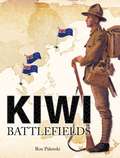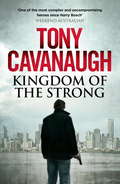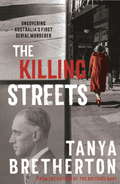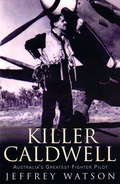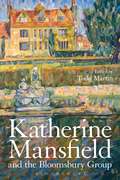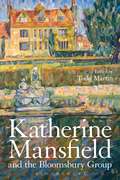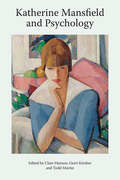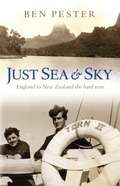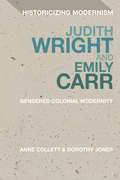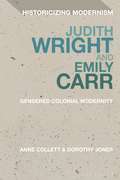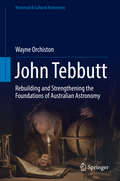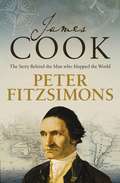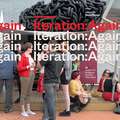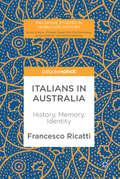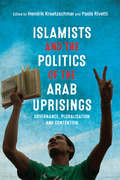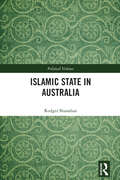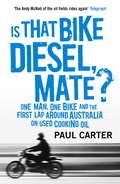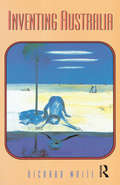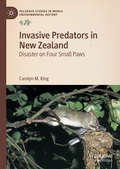- Table View
- List View
Kiwi Battlefields
by Dr Ron PalenskiThe history behind the major battlefields in which New Zealand soldiers fought
Kingdom of the Strong (The Darian Richards Series #4)
by Tony CavanaughAcclaimed crime writer Tony Cavanaugh is back with a gripping new novel featuring Australia's answer to Michael Connelly's Hieronymus Bosch - Darian Richards.Darian Richards is an ex-cop, a good one. He did whatever it took to solve a crime and stop the bad guy. Whatever it took! But after sixteen years as the head of Victoria's Homicide Squad, he'd had enough of promising victims' families he'd find the answers they needed. He had to walk away to save his sanity.Now Police Commissioner Copeland Walsh has tracked Darian down. He needs him to help clear an old case. The death of Isobel Vine. The coroner gave an open finding. An open finding that never cleared the cloud of doubt that hovered over four young cops who were present the night Isobel died.Twenty-five years later, one of those young cops is next in line to become police commissioner, so Copeland Walsh needs the case closed once and for all. In his mind there is only one man for the job. One man who would be completely independent. One man who has never bowed to political or police pressure. One man who knows how to get the job done - Darian Richards.Darian is going back to stir a hornet's nest. But once Darian is on a case he won't back off tracking down evil, no matter who he has to take down.'Cavanaugh has created a fascinating hero who is a law unto himself. Worthy of the world stage' - West Australian 'Cavanaugh's best novel to date' - Sunday Canberra Times'Dark and powerful, this is Cavanaugh's best novel to date' - Newcastle Herald'This is the Cavanaugh's fourth novel, and like the others is outstanding' - Illawarra MercuryThe Darian Richards SeriesPromiseDead Girl SingThe Soft Touch (Short Story)The Train RiderKingdom of the Strong
The Killing Streets: Uncovering Australia's first serial murderer (The Australian Crime Vault)
by Tanya BrethertonFrom the acclaimed author of The Suitcase Baby and The Suicide Bride, the story of a series of horrific murders that began in 1930s Sydney - and a killer who remained at large for over two decades.In December 1932, as the Depression tightened its grip, the body of a woman was found in Queens Park, Sydney. It was a popular park. There were houses in plain view. Yet this woman had been violently murdered without anyone noticing. Other equally brutal and shocking murders of women in public places were to follow. Australia's first serial killer was at large.Police failed to notice the similarities between the victims until the death of one young woman - an aspiring Olympic swimmer - made the whole city take notice. On scant evidence, the unassuming Eric Craig was arrested. But the killings didn't stop...This compelling story of a city crippled by fear and a failing economy, of a killer at large as panic abounds, is also the story of what happens when victims aren't perfect and neither are suspects, and when a rush to judgement replaces the call of reason.
Killer Caldwell: Australia’s Greatest Fighter Pilot (Hachette Military Collection)
by Jeffrey WatsonClive 'Killer' Caldwell was a natural and brilliant pilot, a superb shot, and a born leader. He saw action against the Germans, Italians and Japanese, and remains Australia's greatest ever fighter pilot.Born and brought up in Sydney, it was obvious from an early age that nothing would stand in Caldwell's way. He bluffed his way into the RAAF, then made sure that he was posted to exactly where he thought he should be.His ability was unquestioned by all those around him, and he devised the vital 'shadow shooting' technique which contributed so much to Allied success in the air in the north African campaign, and in northern Australia. But he was never afraid of voicing his opinions to all those above and below him, be it about the training of pilots, or the equipping of Spitfires for use against the Japanese - and for trying to run the show his way...Caldwell ended his military career in the Morotai Mutiny in 1945, where he and a number of other Australian pilots tried to resign their commisions in protest at not being allowed by General MacArthur - and the RAAF - to take part in the main action. And then he was embroiled in the Barry inquiry into booze smuggling by him and other pilots...Killer Caldwell is a colourful portrait of a colourful Australian.
Katherine Mansfield and the Bloomsbury Group
by Todd MartinThe New Zealand-born writer Katherine Mansfield associated intimately with many members of the Bloomsbury group, but her literary aesthetics placed her at a distance from the artistic works of the group. With chapters written by leading international scholars, Katherine Mansfield and the Bloomsbury Group explores this conflicted relationship. Bringing together biographical and critical studies, the book examines Mansfield's relationships – personal and literary – with such major Modernist figures as Virginia Woolf, T.S. Eliot, Aldous Huxley and Walter de la Mare as well as the ways in which her work engaged with and reacted against Bloomsbury. In this way the book reveals the true extent of Mansfield's wider influence on 20th-century modernist writing.
Katherine Mansfield and the Bloomsbury Group
by Todd MartinThe New Zealand-born writer Katherine Mansfield associated intimately with many members of the Bloomsbury group, but her literary aesthetics placed her at a distance from the artistic works of the group. With chapters written by leading international scholars, Katherine Mansfield and the Bloomsbury Group explores this conflicted relationship. Bringing together biographical and critical studies, the book examines Mansfield's relationships – personal and literary – with such major Modernist figures as Virginia Woolf, T.S. Eliot, Aldous Huxley and Walter de la Mare as well as the ways in which her work engaged with and reacted against Bloomsbury. In this way the book reveals the true extent of Mansfield's wider influence on 20th-century modernist writing.
Katherine Mansfield and Psychology (Katherine Mansfield Studies)
by Gerri Kimber W. Todd MartinIn line with the recent surge of critical interest in early psychology, the contributors read Mansfield’s work alongside figures like William James and Henri Bergson, opening up new perspectives on affect in her work. While these essays trace strands within the intellectual milieu in which Mansfield came of age, others explore the intricate interplay between Mansfield’s fiction and Freudian theory, seeing her work as emblematic of the uncanny doubling of modernist literature and psychoanalysis.
Katherine Mansfield and Psychology (Katherine Mansfield Studies)
by Gerri Kimber W. Todd MartinIn line with the recent surge of critical interest in early psychology, the contributors read Mansfield’s work alongside figures like William James and Henri Bergson, opening up new perspectives on affect in her work. While these essays trace strands within the intellectual milieu in which Mansfield came of age, others explore the intricate interplay between Mansfield’s fiction and Freudian theory, seeing her work as emblematic of the uncanny doubling of modernist literature and psychoanalysis.
Just Sea and Sky: England to New Zealand the Hard Way
by Ben PesterThis charming account of the voyage of two men in a small boat half wayround the world from Plymouth to New Zealand in 1953 is a rare insight into a time, not long ago, whensailors had no GPS, electronics, radio or any of the mod cons that wetake for granted today. Without lifejacket or a liferaft, they 'just took what came along', hand steering all the way, navigating by sextant, hand-cranking their engine and using oil lamps for light at night and for navigation. Sailors will be staggered how primitive conditions were only a few decades ago, even though it was the norm at the time.Part travelogue and part adventure story, the two friends encountered drunken harbourmasters, the mafia, the legacy of slavery and lost civilisations in the Pacific. Beautifully written, vivid in its descriptions of the two men's exploits ashore and on board, this quirky and entertaining book will be a fascinating read for sailors and non-sailors alike.'A compelling story - I feel like I have sailed with them.' Yachting Monthly
Just Sea and Sky: England to New Zealand the Hard Way
by Ben PesterThis charming account of the voyage of two men in a small boat half wayround the world from Plymouth to New Zealand in 1953 is a rare insight into a time, not long ago, whensailors had no GPS, electronics, radio or any of the mod cons that wetake for granted today. Without lifejacket or a liferaft, they 'just took what came along', hand steering all the way, navigating by sextant, hand-cranking their engine and using oil lamps for light at night and for navigation. Sailors will be staggered how primitive conditions were only a few decades ago, even though it was the norm at the time.Part travelogue and part adventure story, the two friends encountered drunken harbourmasters, the mafia, the legacy of slavery and lost civilisations in the Pacific. Beautifully written, vivid in its descriptions of the two men's exploits ashore and on board, this quirky and entertaining book will be a fascinating read for sailors and non-sailors alike.'A compelling story - I feel like I have sailed with them.' Yachting Monthly
Judith Wright and Emily Carr: Gendered Colonial Modernity (Historicizing Modernism)
by Anne Collett Dorothy JonesKnitting together two fascinating but entirely distinct lives, this ingeniously structured braided biography tells the story of the lives and work of two women, each a cultural icon in her own country yet lesser known in the other's. Australian poet Judith Wright and Canadian painter Emily Carr broke new ground for female artists in the British colonies and influenced the political and social debates about environment and indigenous rights that have shaped Australia and Canada in the 21st century. In telling their story/ies, this book charts the battle for recognition of their modernist art and vision, pointing out significant moments of similarity in their lives and work. Although separated by thousands of miles, their experience of colonial modernity was startlingly analogous, as white settler women bent on forging artistic careers in a male-dominated world and sphere rigged against them. Through all this, though, their cultural importance endures; two remarkable women whose poetry and painting still speak to us today of their passionate belief in the transformative power of art.
Judith Wright and Emily Carr: Gendered Colonial Modernity (Historicizing Modernism)
by Anne Collett Dorothy JonesKnitting together two fascinating but entirely distinct lives, this ingeniously structured braided biography tells the story of the lives and work of two women, each a cultural icon in her own country yet lesser known in the other's. Australian poet Judith Wright and Canadian painter Emily Carr broke new ground for female artists in the British colonies and influenced the political and social debates about environment and indigenous rights that have shaped Australia and Canada in the 21st century. In telling their story/ies, this book charts the battle for recognition of their modernist art and vision, pointing out significant moments of similarity in their lives and work. Although separated by thousands of miles, their experience of colonial modernity was startlingly analogous, as white settler women bent on forging artistic careers in a male-dominated world and sphere rigged against them. Through all this, though, their cultural importance endures; two remarkable women whose poetry and painting still speak to us today of their passionate belief in the transformative power of art.
John Tebbutt: Rebuilding and Strengthening the Foundations of Australian Astronomy (Historical & Cultural Astronomy)
by Wayne OrchistonThis book marks the centennial of Tebbutt's death with a major biographical account surveying his scientific contributions to astronomy, prefaced with a foreword by Sir Patrick Moore. During the second half of the nineteenth century, Tebbutt was Australia's foremost astronomer. He devoted his time and funds to astronomy, and built a truly international reputation that far surpassed Australia's leading professional astronomers of the day. This book marks the centennial of Tebbutt's death with a major biographical account. Tebbutt's remarkable record of achievement extends over more than half a century.Orchiston's book covers the whole of Tebbutt's career, from his yearly observatory reports and comet discoveries to his time as the first president of Sydney's branch of the British Astronomical Association.
James Cook: The story of the man who mapped the world
by Peter FitzSimonsCaptain James Cook is one of the most recognisable in Australian history - an almost mythic figure who is often discussed, celebrated, reviled and debated. But who was the real James Cook?The name Captain James Cook is one of the most recognisable in Australian history - an almost mythic figure who is often discussed, celebrated, reviled and debated.But who was the real James Cook?This Yorkshire farm boy would go on to become the foremost mariner, navigator and cartographer of his era, and to personally map a third of the globe. His great voyages of discovery were incredible feats of seamanship and navigation. Leading a crew of men into uncharted territories, Cook would face the best and worst of humanity as he took himself and his crew to the edge of the known world - and beyond.With his masterful storytelling talent, Peter FitzSimons brings James Cook to life. Focusing on his most iconic expedition, the voyage of the Endeavour, where Cook first set foot on Australian and New Zealand soil, FitzSimons contrasts Cook against another figure who looms large in Australasian history: Joseph Banks, the aristocratic botanist. As they left England, Banks, a rich, famous playboy, was everything that Cook was not. The voyage tested Cook's character and would help define his legacy.Now, 240 years after James Cook's death, FitzSimons reveals what kind of man James was at heart. His strengths, his weaknesses, his passions and pursuits, failures and successes.JAMES COOK reveals the man behind the myth.
Iteration: 13 Public Art Projects Across Tasmania:again
by David CrossIteration:Again documents and reflects upon a series of thirteen temporary public art commissions by twenty-one Australian and international artists that took place across Tasmania from September 18 to October 15, 2011. Produced by Contemporary Art Spaces Tasmania and David Cross, in conjunction with seven partner curators, Iteration:Again presents a compelling array of temporary artworks in largely unexpected places throughout Tasmania. Working to transform our experience of place for a moment in time, each commission seeks to address how temporary interventions or responses by artists to public sites, environments and buildings can serve to open up new ways of understanding Tasmania as a place with very complex cultural, social and spatial resonances. How it might be possible to introduce transformative elements that challenge the notion of a fixed or definitive artwork grounded in one location? By asking the artists to make four different chapters or ‘iterations’ over the course of a four-week period, David Cross challenged each practitioner to think through how change or processes of transition may function to make the art experience an unstable and contingent one. This idea of incorporating change into the work highlights a growing interest by artists in emphasizing art as a potentially theatrical or even fictive medium with the audience experiencing different moments or stages of encounter over a number of weeks. The idea provided for the possibility of narrative sequences, formal investigations, or temporal shifts that saw key additions or subtractions over time. Each commission sought to recast our understanding of public artwork from a discrete event or viewing experience, to a suite of experiences.
Italians in Australia: History, Memory, Identity (Palgrave Studies in Migration History)
by Francesco RicattiThis book provides a concise and innovative history of Italian migration to Australia over the past 150 years. It focuses on crucial aspects of the migratory experience, including work and socio-economic mobility, disorientation and reorientation, gender and sexual identities, racism, sexism, family life, aged care, language, religion, politics, and ethnic media. The history of Italians in Australia is re-framed through key theoretical concepts, including transculturation, transnationalism, decoloniality, and intersectionality. This book challenges common assumptions about the Italian-Australian community, including the idea that migrants are ‘stuck’ in the past, and the tendency to assess migrants’ worth according to their socio-economic success and their alleged contribution to the Nation. It focuses instead on the complex, intense, inventive, dynamic, and resilient strategies developed by migrants within complex transcultural and transnational contexts. In doing so, this book provides a new way of rethinking and remembering the history of Italians in Australia.
Italians in Australia: History, Memory, Identity (Palgrave Studies in Migration History)
by Francesco RicattiThis book provides a concise and innovative history of Italian migration to Australia over the past 150 years. It focuses on crucial aspects of the migratory experience, including work and socio-economic mobility, disorientation and reorientation, gender and sexual identities, racism, sexism, family life, aged care, language, religion, politics, and ethnic media. The history of Italians in Australia is re-framed through key theoretical concepts, including transculturation, transnationalism, decoloniality, and intersectionality. This book challenges common assumptions about the Italian-Australian community, including the idea that migrants are ‘stuck’ in the past, and the tendency to assess migrants’ worth according to their socio-economic success and their alleged contribution to the Nation. It focuses instead on the complex, intense, inventive, dynamic, and resilient strategies developed by migrants within complex transcultural and transnational contexts. In doing so, this book provides a new way of rethinking and remembering the history of Italians in Australia.
Islamists and the Politics of the Arab Uprisings: Governance, Pluralisation and Contention
by Hendrik Kraetzschmar Paola RivettiTraces Scotland's changing townscapes over a thousand years
Islamists and the Politics of the Arab Uprisings: Governance, Pluralisation and Contention (Edinburgh University Press)
by Hendrik Kraetzschmar Paola RivettiDemonstrates how the textual output of settler emigration shapes the nineteenth-century literary and artistic imagination
Islamic State in Australia (Political Violence)
by Rodger ShanahanThis book fills a gap in our knowledge about the activities of Western supporters and members of Islamic State by examining the experience of their Australian cohort. More than 200 Australian men, women and children travelled to Syria and Iraq to fight with Islamist groups and to help establish an Islamic State by force. Dozens more assisted Islamic State by supporting those overseas or by planning or carrying out terrorist attacks in Australia. For all that, little is publicly known about the impact of the Syrian conflict on Australia’s radical Islamists. This book provides a well-researched examination of how and why so many Australians travelled to fight for or otherwise supported Islamic State. From the failed attempt to bring down an Etihad passenger plane en route from Sydney to Abu Dhabi, to showing their children holding the heads of Syrian soldiers, Australians were prominent in carrying out Islamic State’s directions. Using a range of Australian and foreign court records, social and mainstream media content, this book provides the first detailed look at who these people were, what tasks they carried out, how they came to adopt this radical view of Islam and what long-term legal and security implications are likely to result from their actions. This book will be of interest to students of terrorism, political Islam and security studies.
Islamic State in Australia (Political Violence)
by Rodger ShanahanThis book fills a gap in our knowledge about the activities of Western supporters and members of Islamic State by examining the experience of their Australian cohort. More than 200 Australian men, women and children travelled to Syria and Iraq to fight with Islamist groups and to help establish an Islamic State by force. Dozens more assisted Islamic State by supporting those overseas or by planning or carrying out terrorist attacks in Australia. For all that, little is publicly known about the impact of the Syrian conflict on Australia’s radical Islamists. This book provides a well-researched examination of how and why so many Australians travelled to fight for or otherwise supported Islamic State. From the failed attempt to bring down an Etihad passenger plane en route from Sydney to Abu Dhabi, to showing their children holding the heads of Syrian soldiers, Australians were prominent in carrying out Islamic State’s directions. Using a range of Australian and foreign court records, social and mainstream media content, this book provides the first detailed look at who these people were, what tasks they carried out, how they came to adopt this radical view of Islam and what long-term legal and security implications are likely to result from their actions. This book will be of interest to students of terrorism, political Islam and security studies.
Is that Bike Diesel, Mate?: One Man, One Bike, and the First Lap Around Australia on Used Cooking Oil
by Paul CarterOi, mate, is that monstrosity diesel? From the author of the bestsellers Don't Tell Mum I Work on the Rigs, She Thinks I'm a Piano Player in a Whorehouse and This Is Not a Drill, this is the eagerly awaited next installment of Paul Carter's rollicking life.Take one mad adventurer and a motorbike that runs on bio fuel (cooking oil i.e. chip fat to you and me) and send them with one filmmaker on a road trip around Australia just to see what happens. What you get is a story full of outback characters, implausible (but true) situations, unlikely events and unfortunate breakdowns, all at a break neck pace. Never one to sit still for long, this is what Paul Carter did next.Whether you've been shocked, delighted, entertained, horrified - or all of the above - by Paul's stories whether from oil rigs or the road one thing is for sure, they are always high octane adventures.
Inventing Australia: Images And Identity, 1688-1980 (Australian Experience Ser. #No. 3)
by Richard White'White sets himself a most ambitious task, and he goes remarkably far to achieving his goals. Very few books tell so much about Australia, with elegance and concision, as does his' - Professor Michael Roe'Stimulating and informative. an antidote to the cultural cringe' - Canberra Times'To be Australian': what can that mean? Inventing Australia sets out to find the answers by tracing the images we have used to describe our land and our people - the convict hell, the workingman's paradise, the Bush legend, the 'typical' Australian from the shearer to the Bondi lifesaver, the land of opportunity, the small rich industrial country, the multicultural society.The book argues that these images, rather than describing an especially Australian reality, grow out of assumptions about nature, race, class, democracy, sex and empire, and are 'invented' to serve the interests of particular groups.There have been many books about Australia's national identity; this is the first to place the discussion within an historical context to explain how Australians' views of themselves change and why these views change in the way they do.
Inventing Australia
by Richard White'White sets himself a most ambitious task, and he goes remarkably far to achieving his goals. Very few books tell so much about Australia, with elegance and concision, as does his' - Professor Michael Roe'Stimulating and informative. an antidote to the cultural cringe' - Canberra Times'To be Australian': what can that mean? Inventing Australia sets out to find the answers by tracing the images we have used to describe our land and our people - the convict hell, the workingman's paradise, the Bush legend, the 'typical' Australian from the shearer to the Bondi lifesaver, the land of opportunity, the small rich industrial country, the multicultural society.The book argues that these images, rather than describing an especially Australian reality, grow out of assumptions about nature, race, class, democracy, sex and empire, and are 'invented' to serve the interests of particular groups.There have been many books about Australia's national identity; this is the first to place the discussion within an historical context to explain how Australians' views of themselves change and why these views change in the way they do.
Invasive Predators in New Zealand: Disaster on Four Small Paws (Palgrave Studies in World Environmental History)
by Carolyn M. KingThe story of invasive species in New Zealand is unlike any other in the world. By the mid-thirteenth century, the main islands of the country were the last large landmasses on Earth to remain uninhabited by humans, or any other land mammals. New Zealand’s endemic fauna evolved in isolation until first Polynesians, and then Europeans, arrived with a host of companion animals such as rats and cats in tow. Well-equipped with teeth and claws, these small furry mammals, along with the later arrival of stoats and ferrets, have devastated the fragile populations of unique birds, lizards and insects. Carolyn M. King brings together the necessary historical analysis and recent ecological research to understand this long, slow tragedy. As a comprehensive historical perspective on the fate of an iconic endemic fauna, this book offers much-needed insight into one of New Zealand’s longest-running national crises.
